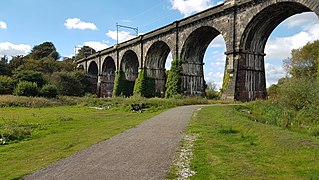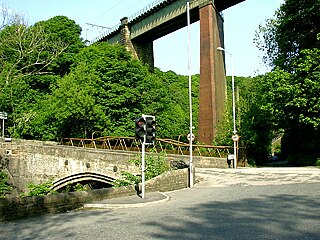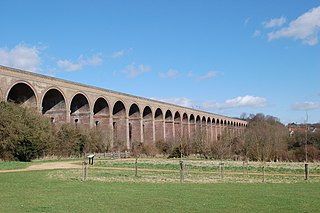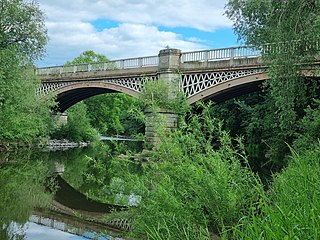
The Sankey Viaduct is a railway viaduct in North West England. It is a designated Grade I listed building and has been described as being "the earliest major railway viaduct in the world".

The Rugby to Leamington Line was a railway line running from Rugby to Leamington Spa. It was a 15-mile (24 km) branch line built by the London and North Western Railway (LNWR) and opened in 1851. The branch connected Leamington with the mainline from London to Birmingham which had been opened in 1838 by the LNWR's predecessor, the London and Birmingham Railway (L&BR).

Stockport Viaduct carries the West Coast Main Line across the valley of the River Mersey in Stockport, Greater Manchester, England. It is one of the largest brick structures in the United Kingdom and a major structure of the early railway age. It is immediately north of Stockport railway station.

The River Irwell Railway Bridge was built for the Liverpool & Manchester Railway (L&MR), the world's first passenger railway which used only steam locomotives and operated as a scheduled service, near Water Street in Manchester, England. The stone railway bridge, built in 1830 by George Stephenson, was part of Liverpool Road railway station. The bridge was designated a Grade I listed building on 20 June 1988.

Corby Bridge is a railway viaduct adjacent to and immediately east of Wetheral railway station at Wetheral, near Carlisle, in north-western England, begun in 1830 and completed in 1834. It is 920 feet (280 m) long and 100 feet (30 m) high, and has been a Grade I listed building since 1 April 1957.

A flying arch is a form of arch bridge that does not carry any vertical load, but is provided solely to supply outward horizontal forces, to resist an inwards compression. They are used across cuttings, to avoid them collapsing inwards.

The Coat of Arms Bridge is a grade II listed structure on the Coventry–Leamington Spa railway line in the Stivichall area of Coventry in the West Midlands of England. The bridge was built by R.B. Dockray for the London and Birmingham Railway 1844 and spans Coat of Arms Bridge Road on the edge of the city's War Memorial Park.

Broadbottom Viaduct is a railway viaduct that spans the River Etherow between Derbyshire and Greater Manchester in England. Originally of wooden construction supported by stone piers, the timber was replaced first with wrought iron box girders, less than 20 years after the viaduct's opening, later followed by steel trusses and more supporting piers.

The Nene Viaduct is a railway bridge immediately south of Peterborough railway station in Cambridgeshire, Eastern England. It was built to carry the Great Northern Railway across the River Nene. It is a Grade II* listed building.

The Chappel Viaduct is a railway viaduct that crosses the River Colne in the Colne Valley in Essex, England. It carries the Gainsborough Line which now is a short branch linking Marks Tey in Essex to Sudbury in Suffolk. The line previously, however, extended to Shelford in Cambridgeshire.

The Midland Counties Railway viaduct is a disused railway viaduct at Rugby, Warwickshire, which crosses over both the A426 Rugby to Leicester road, and the River Avon to the north of Rugby town centre.

Belvidere Bridge is a cast iron arch railway bridge in Shrewsbury, western England, built for the Shrewsbury and Birmingham Railway in 1849. It carries the modern Wolverhampton to Shrewsbury railway line over the River Severn and is a grade II* listed building.

The Wolverton Works canal bridge, or Bridge no. 171C, is a bridge over the Grand Union Canal in Wolverton, Milton Keynes in south-eastern England. It carries a spur from the West Coast Main Line into Wolverton Works. It was built in 1834–1835 for the London and Birmingham Railway under the supervision of Robert Stephenson and has been little modified since. It is a grade II* listed building.

Corby Viaduct is a railway bridge built to carry the Newcastle & Carlisle Railway over the Corby Beck near Great Corby, in the parish of Wetheral, to the east of Carlisle in north-western England. One of the largest structures on the route, it is a grade II listed building.

Brandon Viaduct is a railway viaduct crossing the River Avon between the villages of Brandon and Wolston in Warwickshire. It carries the Birmingham Loop line and is roughly half way between Rugby and Coventry. The bridge was built in around 1835 for the London and Birmingham Railway and is now a grade II listed building.

The Sowe Viaduct is a railway bridge on the Birmingham Loop line crossing the River Sowe at the south-eastern edge of Coventry in central England. Built in 1838, it is a Grade II listed building.

The Sherbourne Viaduct is a railway bridge that carries the Birmingham Loop line across the River Sherbourne in Coventry, central England. Built in 1838, it is a grade II listed building.

Wolverton Viaduct is a railway bridge carrying the West Coast Main Line over the River Great Ouse to the north of Wolverton, part of the City of Milton Keynes, in south-eastern England. Built in 1837 for the London and Birmingham Railway under the supervision of Robert Stephenson, it is one of the largest and most notable structures on the route and is a grade II listed building.

The Blisworth Arch or is a railway bridge in Blisworth, Northamptonshire, in eastern England. It was designed by Robert Stephenson for the London and Birmingham Railway and completed in 1837. It is a grade II listed building and a significant local landmark.

Hampton in Arden packhorse bridge crosses the River Blythe near Hampton in Arden in the West Midlands of England, between Birmingham and Coventry. Dating from the 15th century, it is the only bridge of its kind in the area now covered by the West Midlands, and is a grade II* listed building and a scheduled monument.





















